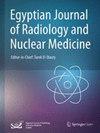Validity of dynamic contrast-enhanced magnetic resonance imaging of the breast versus diffusion-weighted imaging and magnetic resonance spectroscopy in predicting the malignant nature of non-mass enhancement lesions
IF 0.5
Q4 RADIOLOGY, NUCLEAR MEDICINE & MEDICAL IMAGING
Egyptian Journal of Radiology and Nuclear Medicine
Pub Date : 2024-05-13
DOI:10.1186/s43055-024-01267-2
引用次数: 0
Abstract
Breast cancer is the commonest cancer affecting women worldwide. So, it is important to accurately detect and classify different breast lesions. Noninvasive methods for tissue characterization have increased interest, particularly for early diagnosis. Non-mass enhancement (NME) breast lesions are described in magnetic resonance imaging (MRI) as the presence of enhancement without space-occupying lesions. Several studies have described that certain characteristics can be used as new indicators of malignancy in breast NME lesions. We aimed to study the role of multiparametric-MRI (Mp-MRI) as diffusion-weighted imaging (DWI) and magnetic resonance spectroscopy (MRS) in assessment of NME lesions and to suggest which one offers the greatest diagnostic accuracy. This retrospective study was conducted from March 2017 to December 2023 on 220 NME breast lesions. All lesions were analyzed to study the features of benign and malignant NME lesions using different MRI techniques including dynamic contrast-enhanced MRI (DCE-MRI), DWI, and MRS. Breast MRI was performed at 1.5 Tesla, findings were correlated with histopathological results of all cases. Patients’ mean age was 46.56 years with 220 NME breast lesions (54 were benign and 166 were malignant). Invasive ductal carcinoma with ductal carcinoma in situ was the most malignant type representing 93 cases. We found that segmental distribution, heterogeneous enhancement, type III curve, restricted diffusion, lower apparent diffusion coefficient, and positive choline peak were more with malignancy (P = 0.008, 0.02, 0.004, 0.001, and < 0.001). We detected that Mp-MRI has higher diagnostic accuracy than DCE-MRI and combined other functional sequences (DWI, MRS), it was 91.2% with sensitivity 89.9%, specificity 87.8%, positive predictive value 89.2%, and negative predictive value 82.2%. Functional MRI techniques, such as DWI and MRS, can provide helpful information in assessment of NME lesions. They have high diagnostic accuracy, sensitivity, and specificity in characterizing NME breast lesions as benign or malignant. However, DCE-MRI is mandatory for lesion characterization and delineation of its nature and cannot be replaced by them alone in cases of lesion visualization. So, multiparametric-MRI can improve the diagnostic accuracy of NME breast lesions when combined with dynamic contrast-enhanced MRI and can help in reducing negative biopsy rates.乳腺动态对比增强磁共振成像与弥散加权成像和磁共振波谱成像在预测非肿块增强病变的恶性程度方面的有效性比较
乳腺癌是全球妇女最常见的癌症。因此,准确检测和分类不同的乳腺病变非常重要。用于组织特征描述的无创方法越来越受到关注,尤其是在早期诊断方面。在磁共振成像(MRI)中,非肿块增强(NME)乳腺病变被描述为存在增强而不占空间的病变。一些研究表明,某些特征可作为乳腺 NME 病变恶性程度的新指标。我们的目的是研究多参数磁共振成像(Mp-MRI)、弥散加权成像(DWI)和磁共振波谱成像(MRS)在评估 NME 病变中的作用,并提出哪种方法的诊断准确性最高。这项回顾性研究于2017年3月至2023年12月对220例NME乳腺病变进行了研究。对所有病变进行了分析,采用不同的磁共振成像技术(包括动态对比增强磁共振成像(DCE-MRI)、DWI和MRS)来研究良性和恶性NME病变的特征。乳腺磁共振成像在 1.5 特斯拉下进行,所有病例的结果均与组织病理学结果相关。患者的平均年龄为46.56岁,有220个NME乳腺病变(54个为良性,166个为恶性)。浸润性导管癌和导管原位癌是最常见的恶性类型,共 93 例。我们发现,节段性分布、异质强化、Ⅲ型曲线、弥散受限、表观弥散系数较低和胆碱峰阳性与恶性肿瘤的关系更大(P = 0.008、0.02、0.004、0.001 和 <0.001)。我们发现,Mp-MRI 的诊断准确率高于 DCE-MRI,结合其他功能序列(DWI、MRS),Mp-MRI 的诊断准确率为 91.2%,敏感性为 89.9%,特异性为 87.8%,阳性预测值为 89.2%,阴性预测值为 82.2%。功能磁共振成像技术(如 DWI 和 MRS)可为评估 NME 病变提供有用信息。它们在确定乳腺 NME 病变是良性还是恶性方面具有很高的诊断准确性、灵敏度和特异性。然而,DCE-MRI 是确定病变特征和划分病变性质的必备手段,在病变显像的情况下,DCE-MRI 无法单独取代 DCE-MRI。因此,多参数磁共振成像与动态对比增强磁共振成像相结合,可提高 NME 乳腺病变的诊断准确性,并有助于降低活检阴性率。
本文章由计算机程序翻译,如有差异,请以英文原文为准。
求助全文
约1分钟内获得全文
求助全文
来源期刊

Egyptian Journal of Radiology and Nuclear Medicine
Medicine-Radiology, Nuclear Medicine and Imaging
CiteScore
1.70
自引率
10.00%
发文量
233
审稿时长
27 weeks
 求助内容:
求助内容: 应助结果提醒方式:
应助结果提醒方式:


